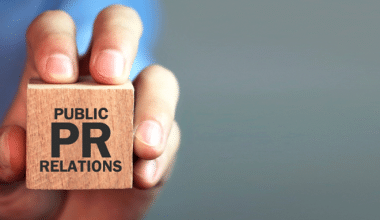Rebranding is a potent instrument for every organization, indicating an opportunity for a new beginning, revitalized vision, and identity reconfiguration. A well-crafted rebranding press release guarantees that all relevant parties, such as devoted clients and influential industry members, are informed of these developments.
A press release promoting a new logo or tagline is not the only thing that makes a rebranding effective. It’s a chance to explain your brand’s history, state your goals, and create excitement for what lies ahead. A well-designed press release template can swiftly reveal the new company logo.
In this article, I will go over how to go about creating an effective press release for an event.
Key Points
- A rebranding press release informs the public, media, and potential customers about a company’s brand identity or strategy change, including details like a new name, logo, mission, or overall image.
- Press releases are still important for building media relations, enhancing brand recognition, gaining publicity, announcing new products, and providing an affordable way to get free publicity.
- Essential components of a rebranding press release include an attention-grabbing headline, contact details, multimedia resources, a brief synopsis, a company overview, leadership quotes, and a boilerplate.
- Consider leadership quotes, visuals, and clear rationale to explain and promote the rebrand while maintaining excitement and confidence.
What Is a Rebranding Press Release?
A rebranding press release is a news release intended for public consumption that introduces a company’s brand identity or strategy change. It gives stakeholders and the general public important information about the company name, logo, mission, or overall image alterations. A news statement about rebranding should adhere to the AP style guidelines and be limited to 350–450 words.
Press releases regarding rebranding are used to enlighten the public, the media, and prospective consumers about the change and to create curiosity, foster excitement, and secure backing for the rebranding initiative. A press release may get you media attention for your rebranding, which can help you gain rapid traction and build brand confidence.
Why is a Press Release Important?
With social media becoming one of the most popular means for reaching large audiences and people’s attention spans growing shorter, it would be easy to dismiss press releases as obsolete. But doing so would be a mistake.
The press release is still essential in every public relations professional’s toolbox. And its value is in offering the following benefits:

#1. Relations with the Media
By distributing a press release, you can build relationships with reporters, journalists, and media influencers. You depend on these individuals to write articles about your company to grow your clientele, enhance your reputation in the community, and widen your network of professional contacts. Building a rapport with the media provides your business with multiple avenues for distributing press releases and other messages in the future.
#2. Brand Recognition
Publicizing your business is vital, as is preserving a favorable brand image and good public relations. A press release assists you in managing a PR crisis or facilitating an acquisition in a way that benefits your firm by facilitating the information cycle. Your brand will gain credibility and confidence if you distribute precise press releases regularly.
#3. Publicity
With a well-written press release, you can capture the attention of journalists, editors, and other media professionals. This might result in immediate exposure for your company via articles that pique the interest of current and prospective customers. When distributed to the appropriate media outlet, your press release can reach an untapped readership you may not have previously considered.
#4. Press Release about the Product
A product press release can be used to announce an exciting development in your firm, such as the debut of a new product or an update. This paper contains the salient characteristics and distinctive advantages that set the product apart from the competition. Certain images and the price are also essential information to generate interest in this kind of press release properly.
#5. Affordability
I vividly remember when my company had our first publicity. It was free because many journalists were interested in the story and wanted to write about it. The purpose of producing a press release has always been to get free publicity. When journalists pick up the story and distribute it to their audiences, they are essentially helping you get the word out about your firm for free. This makes press releases a vital resource for businesses of all sizes, from established corporations to start-ups in their early phases.
Components of a Press Release for Rebranding
A well-written press release for your rebranding should include several essential components to convey the changes to your brand clearly. Start with an attention-grabbing headline summarising the main points of your sample press release.
Give a succinct synopsis of the investor relations goals and the reasoning behind the rebranding. Then, give a brief synopsis of your business’s history and the digital rebranding initiative, emphasizing the addition of new brand elements, including colours, logos, and messaging.
Include leadership quotations and multimedia components to increase credibility. Lastly, for media queries, give your personal information and boilerplate. Let’s dissect and comprehend the elements of a strong press release:
#1. Specifics of the Rebrand
After providing an overview of your organisation, discuss the specifics of your rebranding endeavour. Present the physical components of your new brand identity, such as the messaging, colour scheme, typography, and logo. Describe the strategic thinking that went into these decisions and how they fit in with your brand’s evolving components.
Emphasise the best rebranding strategies, such as stakeholder involvement, audience research, and rollout planning. Explain thoroughly the elements of your successful rebranding while pointing out possible hazards, and then contrast your strategy with sobering accounts of the greatest rebranding errors.
#2. Headline
Creating an attention-grabbing title is essential for a rebranding announcement. It draws attention and effectively communicates the core of your rebranding initiative. Determine the main point you wish to make clear from the outset, whether through a name change, new imagery, or a rebranding marketing plan.
Use action verbs and attention-grabbing terms to draw attention to the most effective rebranding components. Avoid vague language and jargon for succinct, attention-grabbing sentences that spark interest.
To determine audience resonance, run A/B tests and make necessary adjustments. By following these guidelines and avoiding typical mistakes like ambiguity or wordiness, you can create a headline that establishes the tone for your rebranding campaign.
#3. Details of Contact
Having contact information that is easy to find and understand is crucial if you want to answer questions from the public and media about your rebrand. Name someone to handle media inquiries, arrange interviews, and provide supplementary materials. Ensure this contact’s email address, phone number, and online press room link are visible.
General channels such as an info@ email address or customer service hotline should be supplied to address general inquiries about rebranding. A microsite or landing page detailing your rebranding package, including FAQs, brand guidelines, and asset downloads, might also be launched.
#4. Multimedia Resources
Enhance the visual appeal of your rebranding effort with eye-catching multimedia content. Present your redesigned logo, colour scheme, and brand aspects with top-notch photos and videos that follow the latest rebranding trends. Create motion graphics and infographics that succinctly highlight the advantages of rebranding, such as enhanced market positioning or brand recognition.
Use interactive tools like augmented reality filters or virtual product demos to draw viewers into your redesigned brand universe. For a unified presentation, ensure every asset complies with your brand rules and essential messaging. By carefully selecting a collection of rich multimedia content, you can increase the impact of your rebranding news release template.
#5. Brief Synopsis/Description
The next stage is to create a succinct yet useful explanation for your rebranding announcement examples after drawing readers in with an attention-grabbing headline. This part must explain the need for rebranding, discuss market conditions, align the brand identity, or suggest changing the organisation’s name.
Emphasise the main changes, such as a new name, logo, or brand philosophy, without getting too specific. Avoid jargon and concentrate on clarity, making sure the value offer justifies the rebranding’s expense.
Mention pertinent parties and describe the expected effects of the rebrand. Your summary, which strikes the ideal mix between concision and substance, will successfully set the setting for the press release samples that follow.
#6. Boilerplate
Your press release about the rebranding should end with a succinct yet educational boilerplate section. Provide a succinct synopsis of the company’s goals, core principles, and products or services that accurately represent the redesigned brand. Emphasise noteworthy accomplishments, leadership in the field, and an unwavering dedication to your client’s success.
Provide contact details for investor relations, media requests, and general customer interaction. Strengthen the strategic justification for your rebranding initiative by offering this thorough overview. By doing so, you’ll place your rebranding inside the larger story of your business.
#7. Crucial Text
In your rebranding endeavour, clearly state your brand’s story. Condense the core ideas of evolving positioning into brief but impactful messaging. Align this messaging with the rebranding trends of the present, taking into account changes in organisational priorities, industry realities, or consumer values.
If your company wants to alter its name, devise a strong justification emphasising its unique selling points. Reaffirm these themes consistently and familiarly through all means of communication. To guarantee optimal resonance and impact, test and improve your messaging frequently in response to audience input.
#8. Overview of the Company
A strong corporate overview will give your brand transformation context and support. Start by summarizing your business’s history and significant achievements, illustrating the development of your brand. Describe the factors that led to the rebranding, such as changes in the market, the need to strengthen brand positioning, or the desire to take advantage of expansion prospects presented by an acquisition announcement.
Describe the breadth of the rebrand, including components such as a new identity, a rebranded logo, messaging, or more significant organizational changes. Calculate the rebranding expenses and emphasize the expected benefits. Outlining this backdrop can help you present your immediate discharge as a wise business move.
Checklist on the Best Rebranding Press Release.pdf
Rebranding Press Release Examples
You can use this media to announce many kinds of news. Simply stating, “Here’s my business; check it out!” is insufficient. Press releases should only be posted on your page if they make sense.
Below is a list of the top types of press releases. Find out the best practices for each, or modify the examples given.
#1. Collaborations
An announcement of a merger or acquisition is comparable to a press release regarding a new collaboration, although it often carries less weight. All of the components from an M&A release should still be included, but you might need to be more succinct.
Rather than enumerating every advantage for each company involved in a merger or acquisition, concentrate on how they will collaborate and why their distinct skill sets make them an excellent match.
#2. Breaking News About the Company
Breaking news-style press releases were issued nearly every other day during the COVID-19 pandemic, which has impacted nearly every business worldwide in recent years.
Even if you are not interested in the coronavirus, learning to write a release of this kind is still quite helpful. It is best to be ready in advance in case an urgent situation needs to be communicated immediately.
The only effective approach to breaking bad news is to present the facts and offer a thorough explanation. It’s acceptable to leave out any visually arresting picture because the main objective should be to convey all pertinent details.
#3. Event
It does not matter if your event is public or private. Either way, a press release can be useful.
For maximum effect (and more donations), you might wish to attend a large charity gala or fundraising for a nearby cause. As a result, a press release could be a useful tool for organizing your event.
Press releases are also useful for private events, even if the public isn’t invited. It will increase your brand’s recognition and the event’s uniqueness.
#3. Purchases and Mergers
Press announcements about mergers and acquisitions are often written after a deal is finalized. Writing such a release is best done by outlining the facts and then explaining how the merger or acquisition would benefit both companies.
A merger announcement could also contain multiple quotes from each party, which are significant components. The release gains optimism by mentioning numbers from the purchased entity’s most recent reports.
#4. Crisis Communications
Having a public relations strategy in place is fantastic, but there are occasions when internal or external events go astray, and you must deal with the aftermath. Open communication about the subject is always the best policy, whether it’s a product recall, an apology for offensive statements, a response to a global disaster (think COVID), or something else entirely.
When crafting a crisis communications news release, start with a clear and succinct description of what transpired. Then, discuss your plans to solve the situation.
Composing Tips for Press Release Rebranding Template
Writing the ideal press release for a rebranding can be challenging. However, a well-chosen template and compelling information can breathe new life into the press release.
#1. Determine Your Media Targets
Determine which journalists and media outlets are most pertinent to target. Create customized media lists including trade journals, national media, influencers, and bloggers in your field using a media database and monitoring tools. Give priority to journalists covering business news, branding, and marketing topics related to the main focuses of your rebrand.
To tailor your outreach, find out about each journalist’s interests and preferred methods of pitching. Interact with their earlier material to establish a connection and offer your distinct viewpoint. By selecting the appropriate media contacts early on, you may build significant connections with key personalities in your industry and increase visibility and trust.
#2. Leadership Quotes
It’s crucial to include quotes from executives, such as the CEO or CMO, in your rebranding news release to give it credibility and authority. Determine which key executives are leading the rebranding effort so they can offer reliable, first-hand accounts.
Executives must communicate the strategic vision for branding, which outlines the goals, objectives, and concrete effects for the business and its clients. They also need to add personality by letting their voices be heard and making audacious or motivating remarks that support the brand’s messaging.
Quotations must be clear, meaningful, and free of promotional speak. When skillfully incorporated, leadership quotations may humanize the company narrative and validate the relevance of the rebrand.
#3. Search Engine Optimization
As I will always say, it is essential to optimize your press release for search engines while rebranding to increase online discoverability and visibility. Incorporate SEO keywords throughout the release’s body copy, headers, multimedia, and title in an organic and easy way for readers to read.
Write a succinct, intriguing meta description to persuade visitors to click through. Provide internal connections to your website’s main pages to promote better site architecture and possibly increase traffic.
#4. Identify the People You Want to Reach
It’s important to identify your target demographic precisely before writing your rebranding news release. Divide your consumer base into discrete groups according to their involvement levels, psychographics, and demographics. Make sure that your messaging and distribution tactics are appropriate for each category.
By attending to their individual demands and reiterating your common ideals, prioritize keeping your current clientele and developing brand loyalty. Don’t ignore potential clientele; use your rebranding to raise brand awareness and win over new, devoted followers.
#5. Writing the Press Release for the Rebranding
When we were creating my company’s template for rebranding, our focus was on drawing readers in right away with a catchy headline that alludes to the change in your brand’s identity. In the first few paragraphs, we had to summarise the main motivations for rebranding, emphasizing how it fits our changing market position, offers, and vision.
We also used colourful language and real-world examples to capture interest and explain how the rebrand will affect stakeholders, employees, and customers. Include leadership quotations that bolster the competitive advantages and strategic justification.
#6. Collect Important Data
Before writing your press release, you must thoroughly understand the rebranding process and brand strategy. Stakeholder consultation, audience sentiment analysis via rebranding survey questions, and risk analysis of possible rebranding hazards such as consumer confusion or diminished brand equity are all recommended.
Examine your rebranding rollout plan, which includes implementation details, budgets, and schedules for each customer touchpoint. Collect supporting information, graphic materials, and essential messaging that validate the strategic reasoning behind your rebrand.
What is an example of a rebrand launch?
Rebranding is the alteration of a brand’s identity to establish a new perception or market position. A branding launch introduces a new brand, logo, app, software, or product. A rebranding may entail altering the target market, target audience, slogan, vision, mission, and company values.
How do you introduce a company name change?
A company name change can be announced via email, the website, social media, or a formal blog post from the CEO. The message must be upbeat and passionate to inspire confidence and excitement in all clients.
Conclusion
Using standard press release templates when writing a news release is crucial. You can incorporate the required information more easily if you use a template made specifically for the announcement you’re creating. You can make it simple for media professionals and the public to access this way. A press release’s primary objective is to get media attention. Therefore, providing relevant material and adhering to the format guidelines is critical. If you don’t, your press release can be unclear, and you might miss important chances to get featured in the media.
Related Articles
- My Most Effective News Release Templates for the Best Results
- How to Write News Release: Free Tips and Examples
- Advertising vs. Marketing: Which Should Your Business Focus On More?
- Corporate Communications: Strategies to Amplify Your Brand’s Message





